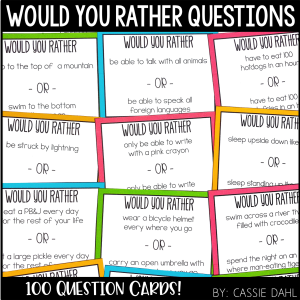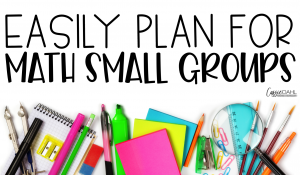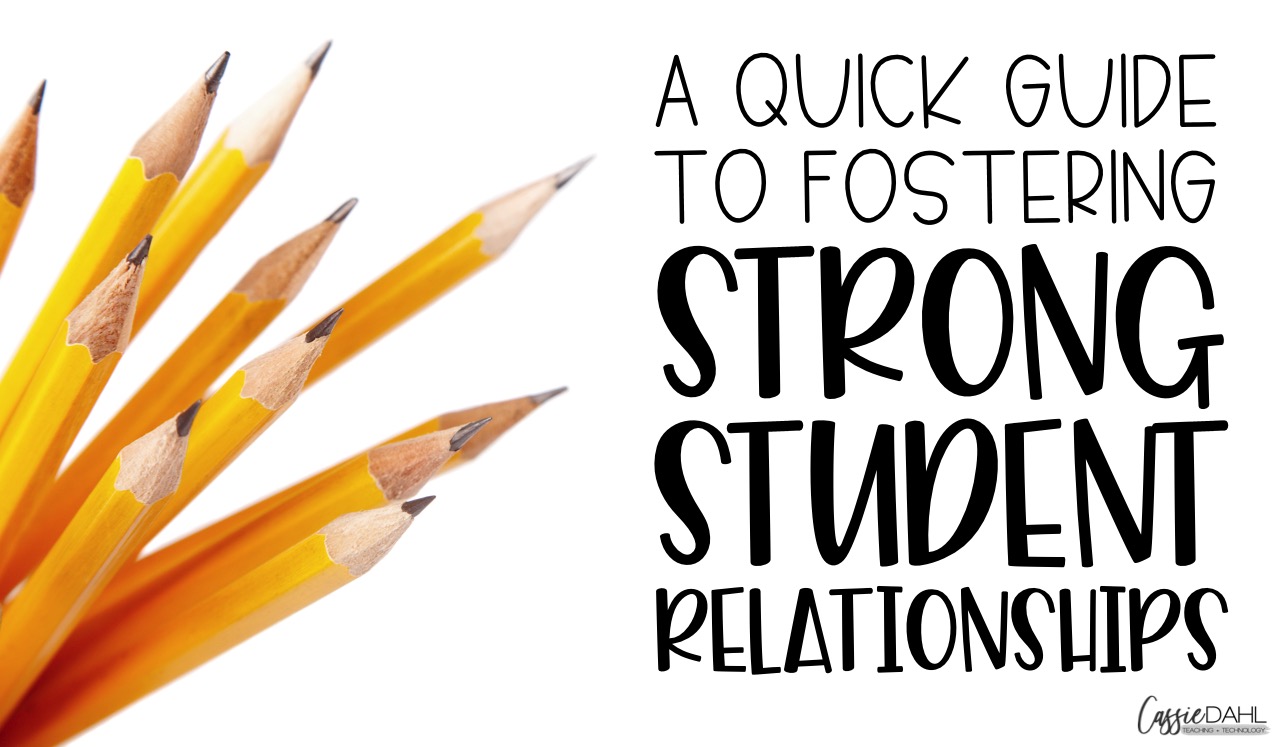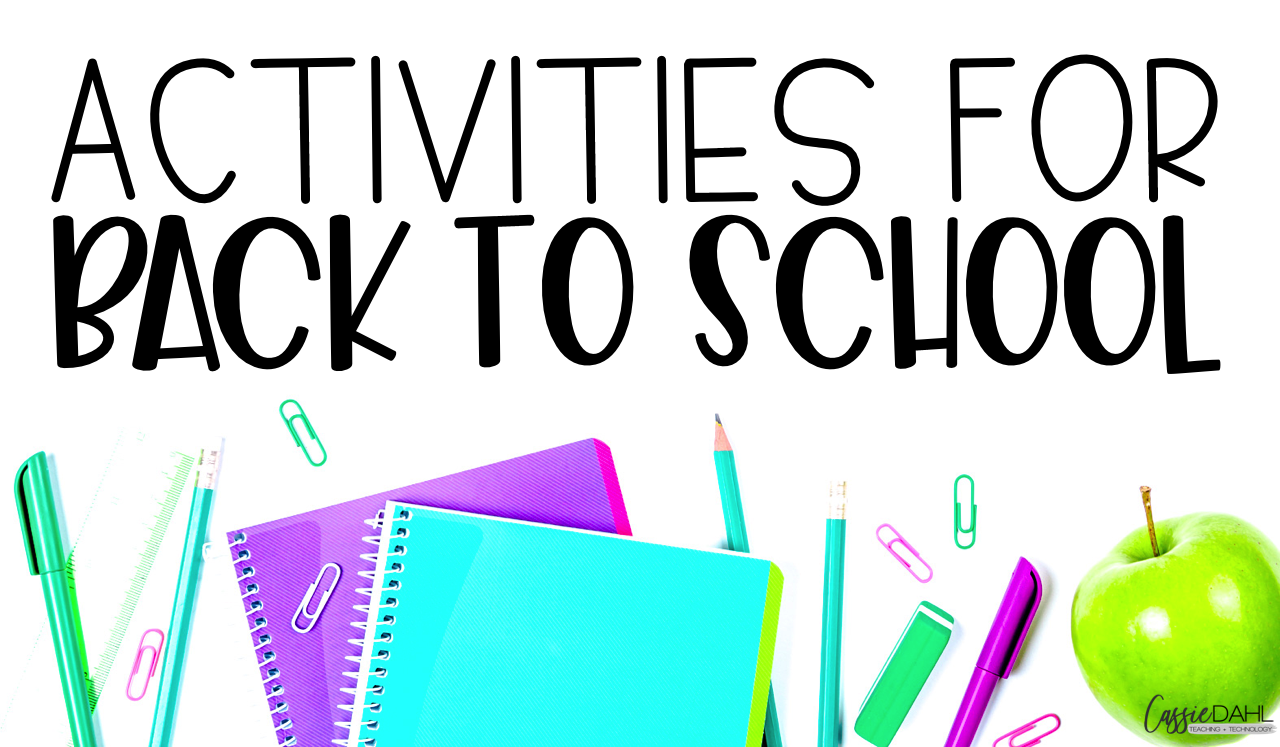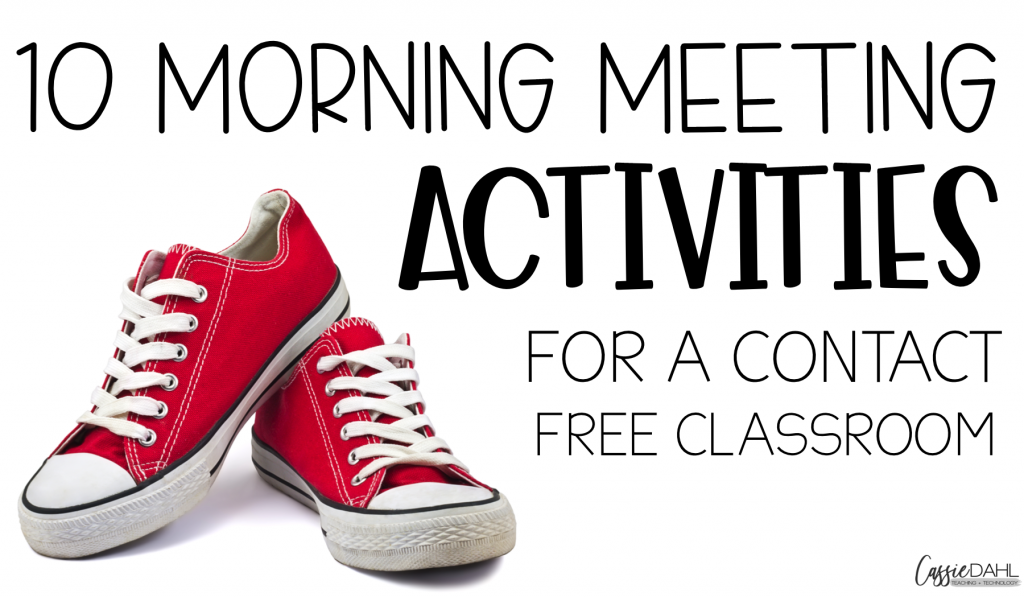
Are you prepping for the new school year and wondering how you are going to make morning meeting work in your classroom? I have brainstormed 10 different morning meeting activities that allow your students to have fun, while being contact free. Build your classroom community with these quick and easy activities!
Three Clues:
This is a favorite in my classroom! Have a student choose a random object. Once they have selected their object (you can have them jot it down on a sticky note so you can see), have them share three clues about their random object with their peers. Remind them that the clues need to be obvious enough that students can figure it out, but not too obvious that they will give it away immediately.
The more times you play this game, the better (and more clever) students will get with their guessing and clues. You might need to model a few times for them to get the hang of it! Another great way to introduce it is to have students start by picking objects IN the classroom as the random object so your class can look around to figure it out.
Body Rhythms:
This is a fun activity (or time filler). One student is the “director” and the rest of the students are the “band”. The director will make a rhythm using their hands/feet/body. For example, they may clap twice – pat their knees once – snap three times. Then the band repeats the rhythm back to the director.
When you first introduce this to students, limit the number of “beats” that students can include in their rhythms. Slowly add beats to make the activity more fun and challenging! Some other easy body sounds are stomping, tapping fingers on desk, clicking their tongue, etc. Kids get pretty clever with different ways they can make a rhythm.
Sparkle:
This is a great game to practice vocabulary words, spelling, or even student names. Students will need to be arranged in some kind of order in the classroom. This can be right at their desks, just identify the order in which they will be going for the game. Start by saying a word. The first student in the order says the first letter, the second student says the second letter, and so on. Once the word has been completed, the next person says “Sparkle” and the person following them is out. If a student misspells a word, they are out and the next person in the order needs to say the correct letter.
Stand Up If:
This is a unique twist on my Step Back If Activity that my students LOVE at the beginning of the year. Create a list of prompts for students to “Stand Up If…” the statement applies to them. For example, “stand up if you like mashed potatoes”. Students who do like mashed potatoes, stand up. Students who do not like mashed potatoes, stay seated. Reset and move on to the next question. The activity allows students to really get to know each other fast! Be sure to participate right along with your class.
Use this any time of year by simply changing up the questions. You can even make them seasonal (example for winter: stand up if you like to go sledding). Don’t have time to figure out a bunch of prompts? I recently updated my Step Back If Activity to also include Stand Up If… prompts! Grab it below.
In My Suitcase:
This activity is sure to get some giggles in your classroom! Pretend that you are all going on a trip. Each student is going to pack an item in the suitcase AND all the items that were listed before them. So, the last student to pack their suitcase is going to add their item and all of their classmates’ items too!
Start by identifying the order in which students will participate. The first student says, “In my suitcase I pack a ______”. We will use hippo for this example, but they could pack anything. The second student says, “In my suitcase I pack a ______ and a hippo). We will use bubblegum for this example, but they could pack anything. The third student says, “In my suitcase I pack a ______, bubblegum and a hippo”. And so on. Students try to name the items for each person in the order that they were added to the suitcase. There are a few variations to the game:
- Students need to add items in a specific category (food, animals, states, etc.).
- Students need to add an item that starts with the same letter of their first name.
- Students need to add an item that is related to the item listed before (example: banana, monkey, circus tent, cotton candy, ferris wheel, etc.).
- Allow your students who are more confident to wait it out to go at the end of the activity, rather than having your students who are more nervous going last.
- Mega Challenge – you go last. Can you name everything that was added to the suitcase?
Fifteen and Out:
This game is so fast and students love it. Identify an order in which students will participate. Students are going to be counting to fifteen by saying one, two or three numbers at a time. The student that “gets stuck” with fifteen is out.
The first student to go could say one OR one two OR one two three. Then the next student would say up to the next three numbers. The process would repeat until you get to fourteen, at which point the next player is out. I make a BIG deal of having students say “sorry” to the person they get out. It’s a good habit to get into. This game can be frustrating because someone is going to get out, even before they have had a chance to say a number.
The game continues until you are down to just one player left! Students will quickly learn the strategy behind the game and start to team up with classmates. It’s a lot of fun. When they are “getting comfortable” with the game, try different target numbers (seventeen, twenty-two, etc.).
Directed Drawings:
Directed drawings are a great alternative to a typical morning meeting activity. They also work great in a pinch for inside recess. Art for Kids Hub has tons of directed drawings that are perfect for students! You can leave it up to your class to pick something to draw, allow students to choose what they want to draw if you have 1:1 devices or pick something seasonal for the whole class to draw!
I always stretch directed drawings out over multiple days. Usually I give students one day to draw their picture and then one day to color it.
Would You Rather:
This is one of my personal favorite morning meeting activities. It is so easy to play and students love it. Simply ask your students a Would You Rather question. They can take turns saying what they would rather do (you can have them explain why they chose their option too if you want). The more off the wall the Would You Rather question, the better!
Any Would You Rather question works, but I have put together a set of Would You Rather question cards that you can just print and keep in your desk for this activity! The set includes 100 total questions (60 regular and 40 YUCK questions that students just LOVE). Grab the pack below.
Simon Says:
This is an oldie, but a goodie! Students love Simon Says. Simply pick a student to be “Simon”. They will say a command to the class and the class will do the command. However, if they don’t start the command with “Simon says”, any students who completed the command are out.
For example: “Simon says stand on one foot” – the whole class stands on one foot. “Simon says cover one eye” – the whole class covers one eye. “Sit down” – anyone who sits down is out because the command did not start with “Simon Says”. Be sure that the activities students are choosing for the commands are appropriate for your classroom space to remain contact free.
Going on a Picnic:
This is a teacher led activity, but students still love it. Start by naming an object that you are taking with to the picnic. Students will then take turns naming an object that they plan to bring to the picnic as well. Your object will fit under a certain “rule” – students need to use inferencing skills based on what other students have tried to bring to the picnic. If they don’t have an object to bring with that fits under the rule, they can’t attend the picnic.
For example: You would say, “I am going on a picnic and I am going to bring a banana”. The rule could be yellow items, items that are found in the jungle, fruits, etc. You choose the rule, but don’t tell students what it is! Depending on your rule, you will have to tell students whether or not they get to go on the picnic with you.
You can defintiely have students become the leader of this game, but it takes some practice. Here are some rule examples to get you started:
- fruits
- vegetables
- breakfast items
- desert animals
- pets
- four letter words
- specific colored items
- articles of clothing
- brands
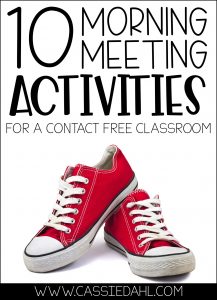
I hope that your students LOVE these activities. Many of them can even be used for more than just morning meeting (brain breaks, downtime, back to school get to know you activities, etc.). Have a favorite contact free activity? Drop it in the comments for other educators to add to their list!


